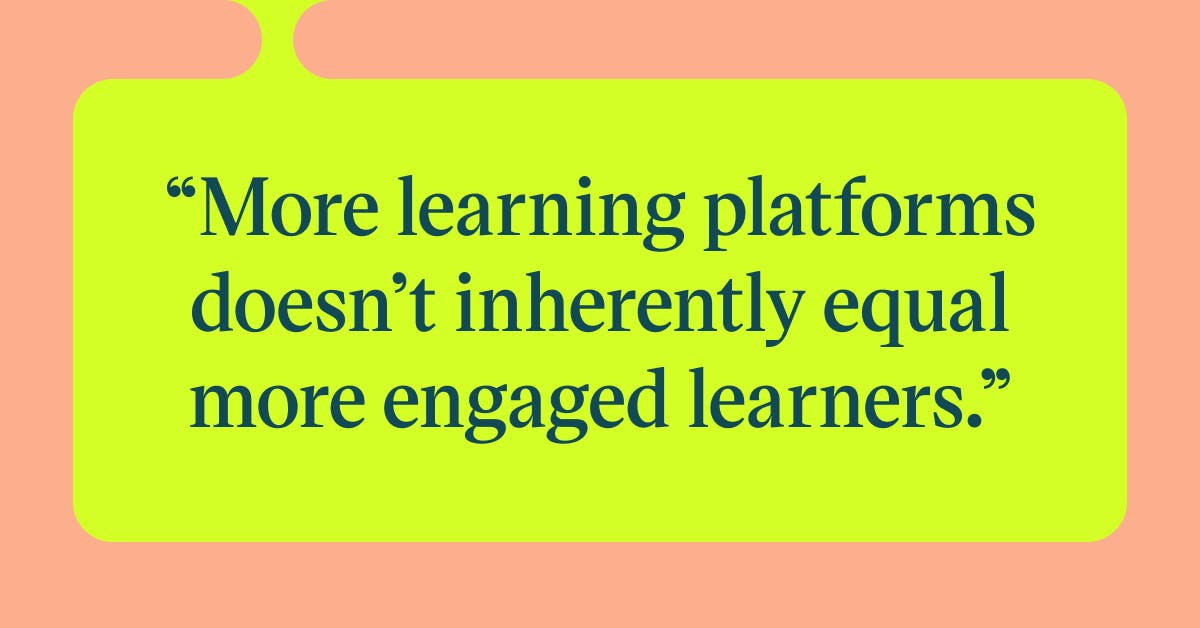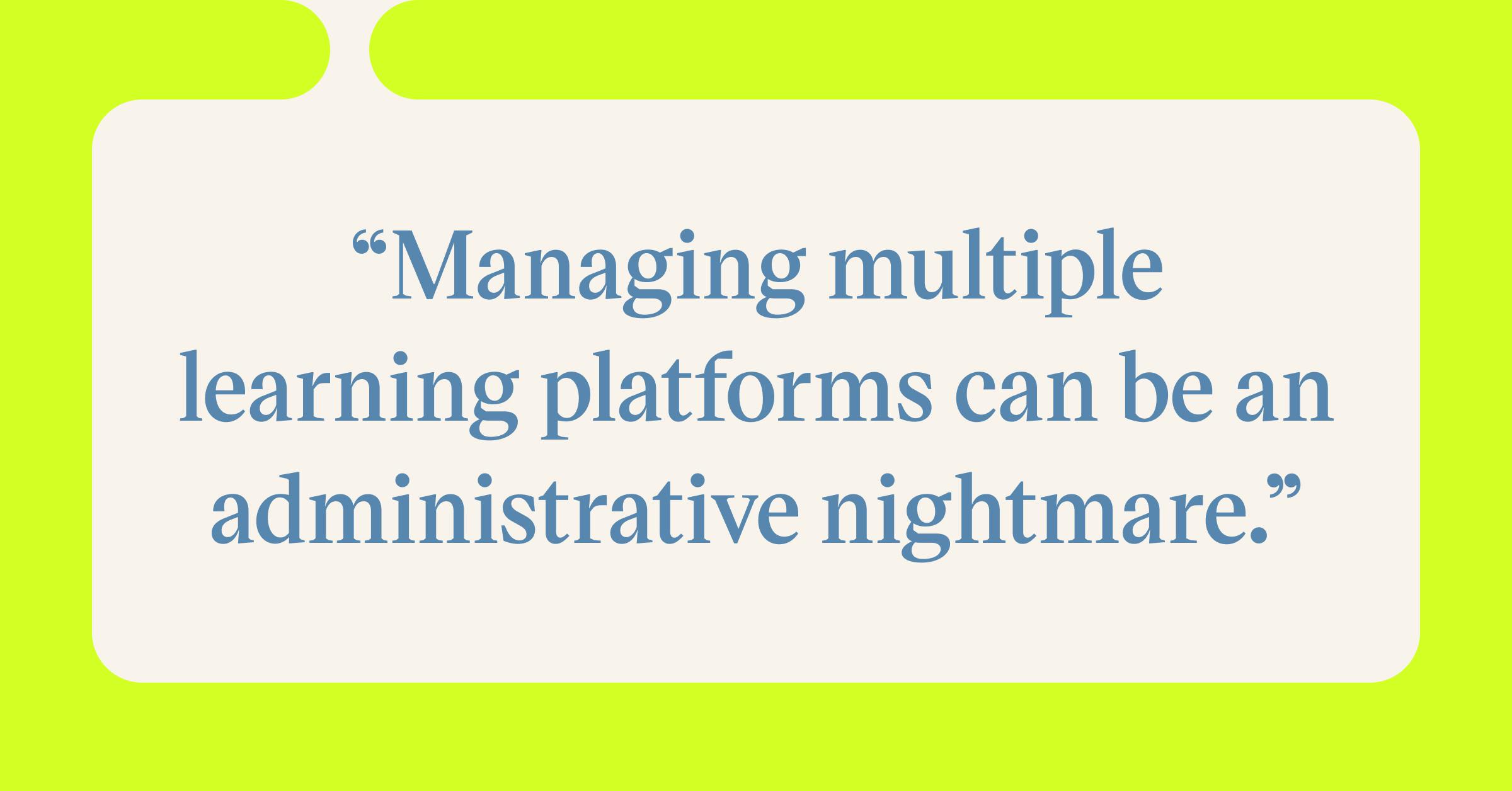
How does having multiple learning platforms impact the learner experience?

In a crowded learning technology landscape, it’s easy for organisations to try to offer the best of all worlds. However, more learning platforms doesn’t inherently equal more engaged learners. Sometimes, it can have the opposite effect. While using multiple learning platforms sounds appealing on paper, this strategy can have drawbacks for the learner, leading to a fragmented learning environment and a lack of alignment.

We’ve decided to dig deeper into the benefits and detriments of having multiple learning platforms, examining three ways that this impacts the learner experience.
1. Most learners prefer a single learning platform
When weighing up the pros and cons of using multiple learning platforms, it is important to remember that most learners prefer to use a single platform. And it’s never a bad time to give your learners what they want.
According to a recent study by Harvard Business, 58% of learners prefer to use a single learning platform compared to 42% of learners who prefer to use multiple learning platforms.
Respondents who preferred a single learning platform cited several benefits, including consistent user interface, a single-vendor relationship, and simplified admin, reporting, and data integration.
One L&D director summarised the benefits of using a single learning platform for his team, saying, “having one platform simplifies the work required on our L&D and HR tech teams and minimises the number of learning platforms for the end user.”
A recent survey from eLearning Industry corroborates these findings, revealing that 78% of respondents feel that L&D must incorporate content aggregation as a new skill (i.e. a single, centralised learning hub).
For further insights on this topic, be sure to read our articles on why content aggregation is changing L&D and how to centralise your learning to avoid information overload.
2. Learners are overwhelmed and lack time for learning
Another vital factor to consider is that having multiple learning platforms can overwhelm users. When many learners already lack time to learn, this is a significant disadvantage.
Currently, employees only spend 24 minutes — or 1% of their time — learning in a typical week, while 49% say they don’t have time to learn at work at all, according to LinkedIn.
Further, a recent study finds that 61.3% of organisations provide less than 20 hours of training per employee per year. Only 28.6% of organisations provide more than 40 hours of training per employee per year. Emerald Works also finds that 45% of managers are reluctant to make time for learning. In other words, most people have hardly any time to learn at work.
When time is set aside for learning, it’s rarely spent in the most streamlined way. According to the IDC, the average “knowledge worker” spends 9.5 hours per week searching for information.
A 2018 study by Josh Bersin adds to this, finding that learners do not suffer from too little content, but rather, “the issue is that there is too much available content, making it a task itself to sift through the bad to get to the valuable.”
Emerald Works supports this theory, finding that 39% of L&D professionals feel overwhelmed and underequipped, while 29% are struggling to keep up with the pace of technological change.
As such, more content may not lead to more engaged learners. Rather, having so many different options can leave learners feeling overwhelmed. When learners spend more time searching for learning content than engaging with content, something has gone wrong.
This is sometimes known as analysis paralysis, which means there are so many options to choose between, that people are unable to make a decision about which one is best for them. For many learners, analysis paralysis makes finding relevant learning content like finding a needle in a haystack. Eventually, these learners will disengage as they tire of swapping from platform to platform.
When you only have 24 minutes per week to dedicate to learning, trying to remember your login details for various platforms, which platforms you have access to, and which platforms house the content you’re looking for can be a significant roadblock. It’s easy to see how analysis paralysis could set in.
The bottom line is that learners are less likely to be proactive if they are confused about where learning content is located. From a learner’s perspective, streamlining learning content into one central platform can have many benefits, making it easier to find relevant content quickly and efficiently.
3. Multiple learning platforms can lead to a fragmented experience
Finally, managing multiple learning platforms can be an administrative nightmare, as you attempt to juggle reporting over several platforms, maintain relationships with different vendors, and manage the costs of multiple platforms. These issues can lead to a fragmented learning experience and a lack of alignment across teams.

For example, using multiple platforms can be expensive, especially as the cost per head increases quickly. Moreover, it can be tricky to manage contracts with more than one content provider, because it involves juggling lots of relationships as well as any hidden costs associated with support and renewal.
Most importantly, using several vendors makes it difficult to manage learning projects effectively. This often results in multiple accounts for learners and a high degree of difficulty when trying to track and report on learner engagement.
These trends should be concerning for L&D teams, as Emerald Works finds that learning management and administration capabilities are trending in the wrong direction without adding an extra degree of difficulty, down from 73% in 2018 to 66% in 2020.
Emerald Works also finds that 26% of L&D teams lack the analytical skills to use learning data effectively. As mentioned, reporting on learner engagement becomes more complex with multiple learning platforms.
Finally, Emerald Works finds that 61% of L&D teams believe they are fully aligned with the strategic goals of their organisation, compared to 94% of high-impact learning cultures. While this is increasing year by year, misalignment is still a common L&D roadblock that a fragmented learning landscape can easily exacerbate.
As one L&D director who spoke to Harvard Business puts it, “single integrated platforms are much better for the end user experience (only going to one place) and for management to track and report progress, develop IDPs, and report on ROI.”
For more insights, be sure to subscribe to the Go1 newsletter to stay on top of all the latest L&D trends. Or, you can book a demo today to find out how Go1 can help with your team’s learning needs.




